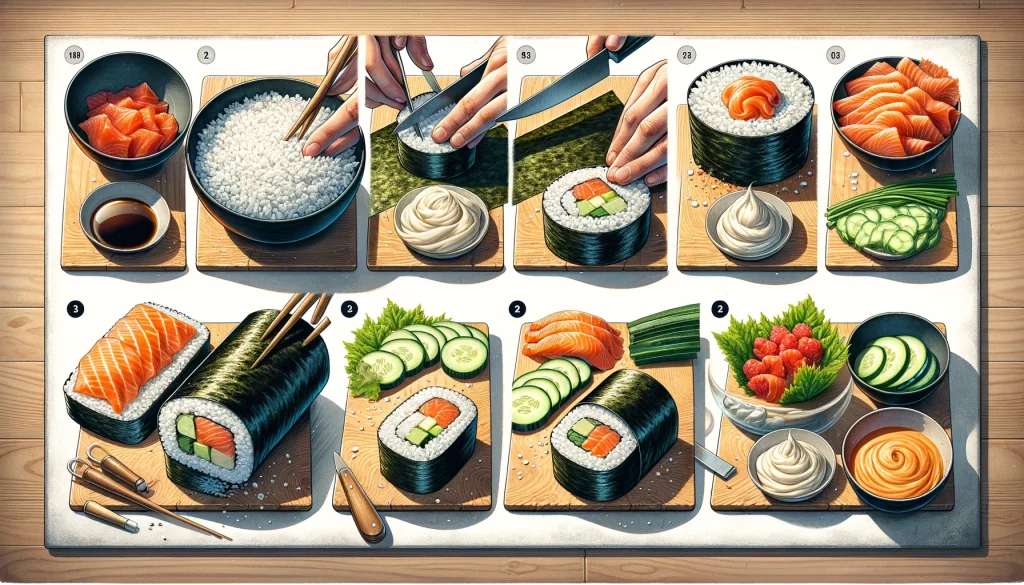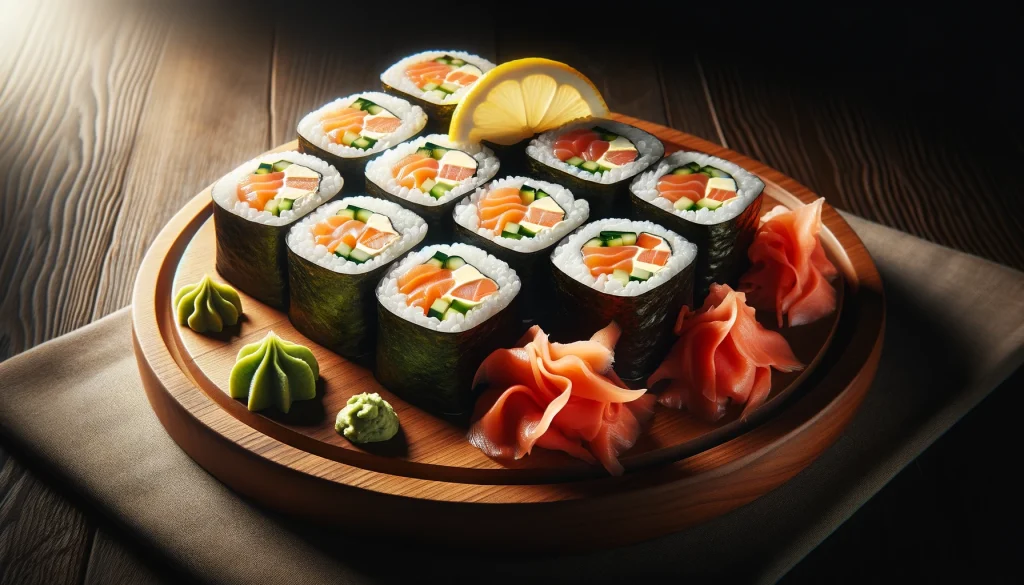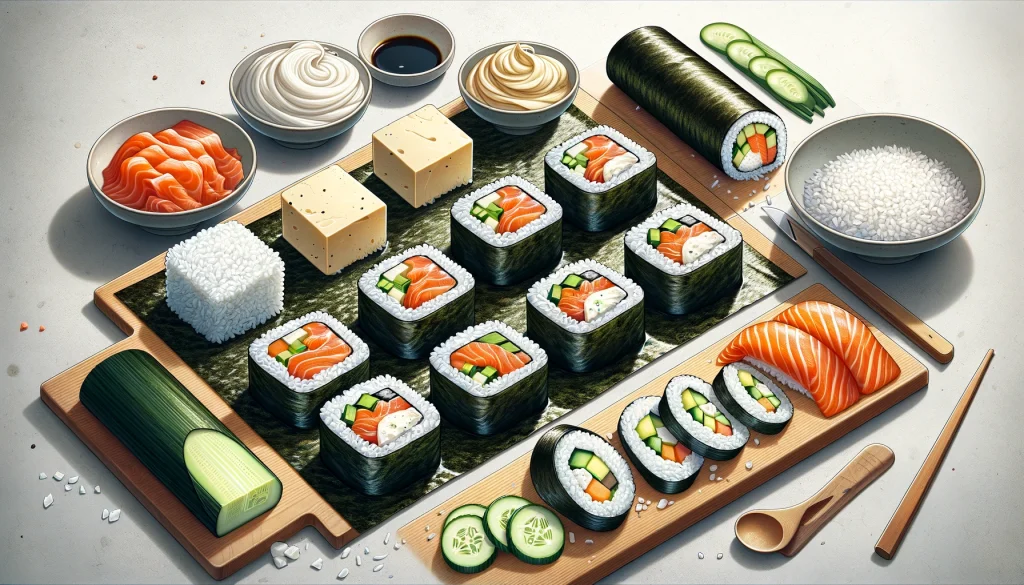As an Amazon Associate I earn from qualifying purchases.
Diving into the world of sushi making brings a delightful array of flavors and textures, and among the most beloved variations in the Western sushi repertoire is the Philadelphia roll. This culinary creation stands out for its unique fusion of East meets West, combining the traditional Japanese sushi technique with ingredients that are staples in American cuisine. The Philadelphia roll, with its creamy core of cream cheese, smoky whispers of smoked salmon, and the crisp freshness of cucumber, offers a delicious contrast of flavors that has captivated sushi lovers far and wide.
Crafting a Philadelphia roll at home might seem like a venture reserved for seasoned sushi chefs, but with the right ingredients, tools, and a bit of patience, anyone can bring this fusion delight to their dining table. The process involves preparing sushi rice to perfection, slicing ingredients to the ideal size, and mastering the art of rolling for that perfect bite. This article will guide you through each step, offering expert tips to ensure your homemade Philadelphia roll is as authentic and delicious as any you’d find in a sushi restaurant.
Whether you’re a seasoned sushi aficionado or a curious novice ready to explore the joys of sushi making, this guide aims to demystify the process and make it accessible and enjoyable. From selecting the right type of rice to achieving the perfect roll, we’ll cover everything you need to know to create this popular sushi roll at home. Let’s embark on this culinary journey together, where creativity meets tradition, and the result is nothing short of delightful.
How to Make A Philadelphia Roll

Making a Philadelphia roll at home can be a delightful culinary adventure, blending the creamy, tangy flavors of cream cheese with the subtle, smoky taste of smoked salmon, all wrapped up with crisp cucumber in sushi rice. Here’s a straightforward recipe to help you craft this popular Western-style sushi roll:
Ingredients:
- 2 cups of sushi rice
- 2 ½ cups of water
- ½ cup of rice vinegar
- 2 tablespoons of sugar
- 1 teaspoon of salt
- 4 sheets of nori (seaweed)
- 8 ounces of smoked salmon, thinly sliced
- 4 ounces of cream cheese, cut into strips
- 1 cucumber, peeled, seeded, and cut into long, thin strips
- Sesame seeds (optional, for garnish)
- Soy sauce, wasabi, and pickled ginger, for serving
Equipment:
- Bamboo sushi rolling mat
- Sharp knife
- Bowl of water (for hands)
Instructions:
1. Prepare the Sushi Rice:
- Rinse the sushi rice under cold water until the water runs clear.
- Combine the rice and water in a rice cooker and cook according to the cooker’s instructions.
- Once cooked, transfer the rice to a large bowl. Mix the rice vinegar, sugar, and salt together, then gently fold this mixture into the warm rice. Spread the rice out to cool to room temperature.
2. Assemble the Philadelphia Roll:
- Place a bamboo sushi rolling mat on a flat surface. Lay a sheet of nori on the mat.
- Wet your fingers to prevent sticking and spread a thin layer of sushi rice evenly over the nori, leaving about a half-inch of nori uncovered at the top.
- Lay strips of smoked salmon, cream cheese, and cucumber across the center of the rice-covered nori.
- Optionally, sprinkle sesame seeds over the top for added texture and flavor.
3. Roll the Sushi:
- Hold the edge of the mat (the edge closest to you) with your thumbs, and start rolling it away from you, applying gentle pressure to make the roll tight.
- Once rolled, use the mat to shape and firm up the roll further. Ensure the uncovered strip of nori seals the roll closed.
4. Cut the Roll:
- With a sharp, wet knife, cut the roll into 6-8 equal pieces. Wetting the knife between cuts helps prevent sticking.
- Arrange the slices on a plate, cut side up.
5. Serve:
- Serve the Philadelphia roll with soy sauce, wasabi, and pickled ginger on the side.
Enjoy your homemade Philadelphia roll, a delightful fusion of Japanese technique and Western flavors that’s sure to impress at any dining table.
Expert Tips

Making a Philadelphia roll at home can be a rewarding experience, allowing you to enjoy this delicious fusion of flavors with a personal touch. Here are some expert tips to elevate your Philadelphia roll-making skills:
1. Select Quality Ingredients:
- Smoked Salmon: Opt for high-quality smoked salmon for the best flavor and texture. Freshness is key, so buy from reputable sources.
- Cream Cheese: Use full-fat cream cheese for its creamy texture and rich taste. It balances well with the tangy flavor of the smoked salmon.
- Cucumber: Choose firm, fresh cucumbers. Remove seeds to avoid excess moisture, which can make the roll soggy.
2. Perfect Your Sushi Rice:
- Rice Texture: The rice should be sticky but not mushy. Washing the rice until the water runs clear removes excess starch and achieves the desired texture.
- Seasoning: Adjust the vinegar, sugar, and salt mixture to taste. The rice should have a subtle tanginess that complements the fillings.
- Cooling: Spread the rice on a wide, flat surface to cool to room temperature quickly. Avoid refrigerating, as this can harden the rice.
3. Rolling Technique:
- Bamboo Mat: Cover your bamboo mat with plastic wrap to prevent sticking and ensure easy cleanup.
- Even Pressure: Apply even pressure when rolling to ensure the roll is tight and holds together, but be careful not to squeeze the fillings out.
- Sharp Knife: A sharp, wet knife is crucial for clean cuts. Wet the knife between cuts to prevent rice from sticking.
4. Presentation and Serving:
- Garnish: A sprinkle of sesame seeds or a dab of roe on top can add a burst of flavor and a professional touch.
- Soy Sauce and Wasabi: Serve with soy sauce for dipping and wasabi for those who enjoy a bit of heat. Pickled ginger on the side is a refreshing palate cleanser.
5. Creative Variations:
- Inside-Out Roll: For a twist, try making an inside-out roll (uramaki) where the rice is on the outside and the nori is on the inside. This adds texture and visual appeal.
- Additional Fillings: Experiment with adding other ingredients like avocado or asparagus for additional flavors and textures.
6. Practice Makes Perfect:
- Trial and Error: Don’t be discouraged by initial attempts. Sushi rolling is an art that improves with practice.
- Consistency: Aim for uniform size and shape with your rolls for a professional look.
7. Mind the Temperature:
- Room Temperature: Serve the Philadelphia roll at room temperature to best enjoy the flavors. The cream cheese and smoked salmon taste best when not too cold.
By following these expert tips, you’ll enhance your ability to make delicious Philadelphia rolls at home, impressing both yourself and your guests with your sushi-making skills. Enjoy the process and the delicious results!
Frequently Asked Questions (FAQ)

Q: What ingredients do I need to make a Philadelphia roll?
A: To make a Philadelphia roll, you’ll need sushi rice, nori (seaweed sheets), smoked salmon, cream cheese, cucumber, and optionally, sesame seeds for garnish. Soy sauce, wasabi, and pickled ginger are also commonly served on the side.
Q: How do I cook the sushi rice correctly?
A: Rinse the sushi rice under cold water until the water runs clear to remove excess starch. Cook the rice according to package instructions or in a rice cooker. Once cooked, mix in a combination of rice vinegar, sugar, and salt while the rice is still warm. Spread it out to cool to room temperature before using.
Q: Can I replace smoked salmon with another type of fish?
A: Yes, while smoked salmon is traditional for a Philadelphia roll, you can substitute it with other types of fish. Sushi-grade raw salmon or even cooked crab meat are popular alternatives. Ensure that any raw fish is sushi-grade to ensure it’s safe for raw consumption.
Q: How thin should the cream cheese be sliced?
A: The cream cheese should be sliced into thin strips, roughly the size of a small pencil. This ensures the cream cheese doesn’t overpower the other flavors and maintains a balanced texture within the roll.
Q: How do I roll the sushi without it falling apart?
A: Use a bamboo sushi rolling mat to help form and tighten the roll. Cover the mat with plastic wrap to prevent sticking. Place the nori on the mat, spread the rice, add your fillings, then use the mat to roll the sushi tightly, applying even pressure. Make sure the ends of the nori meet to seal the roll.
Q: What’s the best way to cut a Philadelphia roll?
A: Use a sharp, wet knife to cut the roll into pieces, cleaning the knife between cuts to prevent sticking. Wetting the knife reduces friction, allowing for cleaner cuts without squashing the roll.
Q: Can I make Philadelphia rolls without a bamboo mat?
A: While a bamboo mat is recommended for ease and consistency, you can make a roll without one by using a piece of parchment paper or a clean kitchen towel as a substitute. These alternatives can help you apply even pressure and roll the sushi, though it may take a bit more practice to achieve the perfect roll.
Q: How long can I store Philadelphia rolls?
A: Philadelphia rolls are best enjoyed fresh, but they can be stored in the refrigerator for up to 24 hours. Wrap them tightly in plastic wrap to maintain freshness. Note that storing them may slightly alter the texture of the rice and nori.
Q: Are Philadelphia rolls healthy?
A: Philadelphia rolls can be part of a balanced diet, but they are higher in calories and fat due to the cream cheese. Opt for light cream cheese and balance your meal with other low-calorie options if you’re watching your calorie intake.
Q: What type of rice is best for making a Philadelphia roll?
A: For making a Philadelphia roll, it’s best to use short-grain Japanese sushi rice. This type of rice has the right balance of stickiness and texture, essential for holding the roll together and achieving the authentic sushi experience.
Q: Can I use fresh salmon instead of smoked salmon for a Philadelphia roll?
A: While traditional Philadelphia rolls are made with smoked salmon for its distinct flavor, you can use fresh salmon if you prefer. If using fresh salmon, ensure it’s sushi-grade to ensure safety for raw consumption. This variation might offer a different taste profile but can be a delightful alternative.
Q: How do I prevent the rice from sticking to my hands when spreading it on the nori?
A: To prevent rice from sticking to your hands, keep a bowl of water with a bit of rice vinegar mixed in nearby. Wet your hands in this solution before handling the rice. This will help the rice not stick to your hands as much.
Q: How thick should the cream cheese slices be for a Philadelphia roll?
A: The cream cheese should be sliced into thin strips, about the thickness of a pencil. This ensures that the cream cheese is not overpowering and blends well with the other ingredients, providing a smooth texture without dominating the roll.
Q: Is there a technique for rolling the sushi tightly without squishing the ingredients?
A: Yes, the key is to use a gentle, even pressure as you roll. Start by lifting the edge of the bamboo mat closest to you, and roll it over the ingredients, tucking the edge of the nori sheet to start the roll. Continue rolling, applying slight pressure to keep the roll tight without squishing the ingredients. Once rolled, shape with the mat for a firm finish.
Q: How can I make my Philadelphia roll look more appealing?
A: Garnishing your Philadelphia roll can enhance its visual appeal. Consider topping the roll with a thin slice of avocado, a sprinkle of sesame seeds, or a drizzle of spicy mayo. These additions not only add to the presentation but also introduce new flavor dimensions.
Q: What is the best way to cut the roll into pieces without it falling apart?
A: A sharp, wet knife is crucial for cutting sushi rolls cleanly. Wet the knife before each cut to prevent the rice from sticking to the blade. Use a gentle sawing motion without applying too much pressure. Cleaning the knife between cuts can also help maintain clean, even slices.
Q: Can I make Philadelphia rolls ahead of time?
A: Philadelphia rolls are best enjoyed fresh due to the rice and cream cheese components. However, if you need to prepare them ahead of time, wrap them tightly in plastic wrap and refrigerate for a few hours. Note that refrigerating for too long can affect the texture and flavor, so it’s best to consume them as fresh as possible.
By following these expert tips, you can master the art of making Philadelphia rolls at home, enjoying the perfect blend of flavors and textures that make this sushi roll a beloved favorite.
Conclusion
Crafting a Philadelphia roll at home invites you into a world where traditional Japanese sushi meets Western culinary creativity. Through the process of selecting ingredients, preparing sushi rice, and mastering the roll, you embark on a culinary journey that not only teaches you the art of sushi making but also allows for personal expression within your creations. The Philadelphia roll, with its harmonious blend of smoked salmon, creamy cream cheese, and crisp cucumber, encapsulates a fusion of flavors that delight the palate and showcase the versatility of sushi.
In concluding our guide on how to make a Philadelphia roll, it’s clear that the key to success lies in attention to detail—from cooking the sushi rice to the right texture, to slicing ingredients for balanced bites, and rolling with care for that perfect sushi shape. Whether you’re a seasoned sushi chef or a curious beginner, making a Philadelphia roll offers a satisfying experience, blending the joy of cooking with the pleasure of sharing delicious, handcrafted sushi with friends and family.
Remember, the beauty of making sushi at home lies in the ability to customize your roll to suit your tastes. Experiment with different levels of cream cheese, try alternative fillings, or adjust the size of your rolls. Each variation not only adds a personal touch but also deepens your understanding and appreciation for the art of sushi making.
As you enjoy the fruits of your labor, remember that each slice of your Philadelphia roll is a testament to the possibilities that arise when cultures collide in the kitchen. So, gather your ingredients, embrace the process, and let the creation of your very own Philadelphia roll be a celebration of culinary fusion that brings joy and flavor to your table.






